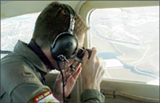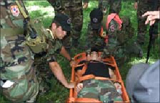|
CAP OPERATIONS
Supporting Our Communities in Times of Need
While CAP has long been associated with search and
rescue missions, its work also includes disaster relief
and communications, as well as counterdrug and homeland
security missions.
Search and rescue remains an important service provided
by CAP members, however. CAP still flies 95 percent
of all federal inland SAR missions, as directed by
the Air Force Rescue Coordination Center (AFRCC) at
Langley AFB, Va. CAP also supports the Joint Rescue
Coordination Centers in Alaska, Hawaii and Puerto
Rico
On average, each year CAP members fly more than 100,000
hours in operational missions and save about 100 lives.
CAP provides air and ground support for disaster relief,
flying officials to remote locations, transporting
blood or live tissue to critical care sites and performing
aerial damage assessment.
CAP has one of the largest unified communications
networks in the country, available 24/7.
In 1986, Congress authorized CAP to assist government
and law enforcement agencies in the fight to eliminate
illicit drug use, production and sale in the US and
its territories. CAP now provides reconnaissance,
communications and transportation for counterdrug
missions.
CAP’s missions succeed through a seamless interplay
of technology and teamwork. With new developments
like satellite imagery and internet-based reporting,
CAP is emerging as the resource of choice to support
our nation’s strategy for homeland security.
Click
here for the CAP Operations section
NOTE: LINKS OR REFERENCES TO INDIVIDUALS
OR COMPANIES DOES NOT CONSTITUTE AN ENDORSEMENT OF
ANY INFORMATION, PRODUCT OR SERVICE YOU MAY RECEIVE
FROM SUCH SOURCES.
|


